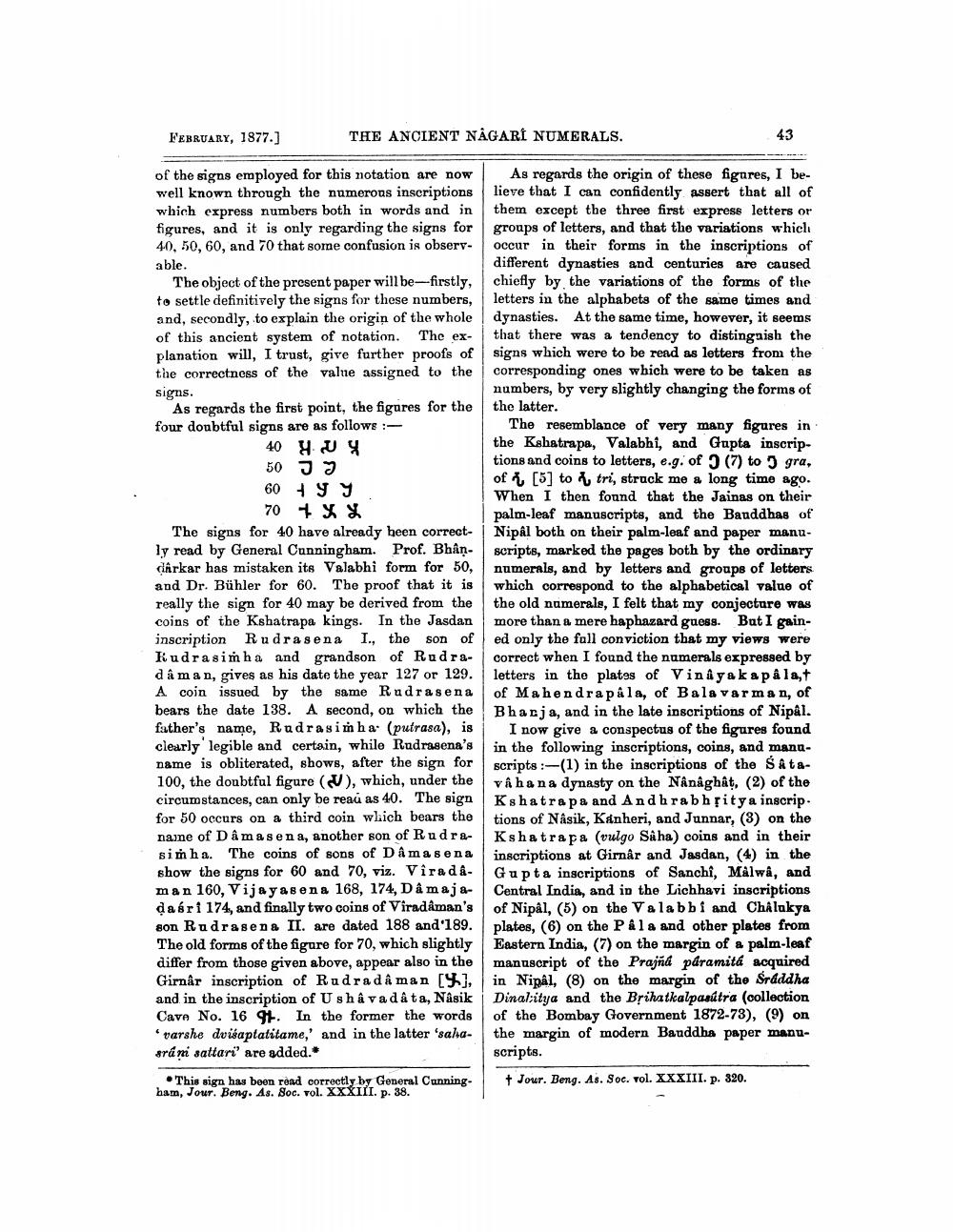________________
FEBRUARY, 1877.]
of the signs employed for this notation are now well known through the numerous inscriptions which express numbers both in words and in figures, and it is only regarding the signs for 40, 50, 60, and 70 that some confusion is observable.
THE ANCIENT NAGARI NUMERALS.
The object of the present paper will be-firstly, to settle definitively the signs for these numbers, and, secondly, to explain the origin of the whole of this ancient system of notation. The explanation will, I trust, give further proofs of the correctness of the value assigned to the signs.
As regards the first point, the figures for the four doubtful signs are as follows:
Y
40
50 ปี ปี
60
70
49 У XL
The signs for 40 have already been correctly read by General Cunningham. Prof. Bhândarkar has mistaken its Valabhi form for 50, and Dr. Bühler for 60. The proof that it is really the sign for 40 may be derived from the coins of the Kshatrapa kings. In the Jasdan inscription Rudrasena I., the son of Kudrasimha and grandson of Rudrad â man, gives as his date the year 127 or 129. A coin issued by the same Rudrasena bears the date 138. A second, on which the father's name, Rudrasimha (putrasa), is clearly legible and certain, while Rudrasena's name is obliterated, shows, after the sign for 100, the doubtful figure (V), which, under the circumstances, can only be reau as 40. The sign for 50 occurs on a third coin which bears the name of Dâmasen a, another son of Rudrasimha. The coins of sons of Dâmasena show the signs for 60 and 70, viz. Viradâman 160, Vijayasena 168, 174, Dâ majadasri 174, and finally two coins of Viradâman's son Rudrasena II. are dated 188 and 189. The old forms of the figure for 70, which slightly differ from those given above, appear also in the Girnår inscription of Rudradâ man [], and in the inscription of U shâvadâ ta, Nâsik Cave No. 16 9. In the former the words varshe dvisaptatitame,' and in the latter 'sahasráni sattari' are added.*
This sign has been read correctly by General Cunningham, Jour. Beng. As. Soc. vol. XXXIII. p. 38.
43
As regards the origin of these figures, I believe that I can confidently assert that all of them except the three first express letters or groups of letters, and that the variations which occur in their forms in the inscriptions of different dynasties and centuries are caused chiefly by the variations of the forms of the letters in the alphabets of the same times and dynasties. At the same time, however, it seems that there was a tendency to distinguish the signs which were to be read as letters from the corresponding ones which were to be taken as numbers, by very slightly changing the forms of the latter.
The resemblance of very many figures in the Kshatrapa, Valabhi, and Gupta inscriptions and coins to letters, e.g. of (7) to 5 gra, of [5] to tri, struck me a long time ago. When I then found that the Jainas on their palm-leaf manuscripts, and the Bauddhas of Nipâl both on their palm-leaf and paper manuscripts, marked the pages both by the ordinary numerals, and by letters and groups of letters which correspond to the alphabetical value of the old numerals, I felt that my conjecture was more than a mere haphazard guess. But I gained only the full conviction that my views were correct when I found the numerals expressed by letters in the plates of Vinayakapala,t of Mahendrapala, of Balavarman, of Bhanja, and in the late inscriptions of Nipâl.
I now give a conspectus of the figures found in the following inscriptions, coins, and manuscripts:-(1) in the inscriptions of the Śâtavahana dynasty on the Nânâghât, (2) of the Kshatra pa and Andhrabhṛity a inscrip. tions of Nasik, Kanheri, and Junnar, (3) on the Kshatrapa (vulgo Saha) coins and in their inscriptions at Girnâr and Jasdan, (4) in the Gupta inscriptions of Sanchi, Malwâ, and Central India, and in the Lichhavi inscriptions of Nipâl, (5) on the Valabbi and Chalukya plates, (6) on the P âla and other plates from Eastern India, (7) on the margin of a palm-leaf manuscript of the Prajñá páramitá acquired in Nipal, (8) on the margin of the Śráddha Dinalitya and the Brihatkalpasútra (collection of the Bombay Government 1872-73), (9) on the margin of modern Bauddha paper manuscripts.
Jour. Beng. As. Soc. vol. XXXIII. p. 320.




